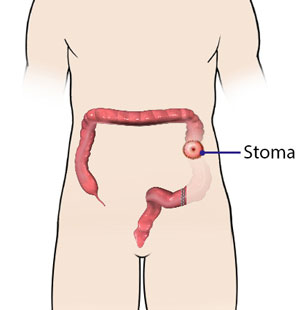Stoma

What is a Stoma?
A stoma is an artificial opening surgically made on the abdomen for excretion of digestive and urinary wastes (faeces and urine) from the body when the large bowel (colon and rectum) and urinary bladder have been malfunctioning or have been removed as a result of a medical condition.
Indications for a Stoma
Your surgeon may recommend creation of a stoma for the treatment of the following medical conditions:
- Bladder cancer
- Bowel cancer
- Ulcerative colitis
- Crohn’s disease
- Diverticulitis
- Obstruction of the bowel or bladder
Preparation for Stoma Surgery
Pre-procedure preparation for creation of a stoma generally involves the following steps:
- A thorough examination is performed by your doctor to check for any medical issues that need to be addressed prior to surgery.
- Depending on your medical history, social history, and age, you may need to undergo tests such as blood work and imaging to help detect any abnormalities that could threaten the safety of the procedure.
- You will be asked if you have allergies to medications, anaesthesia, or latex.
- You should inform your doctor of any medications, vitamins, or supplements that you are taking.
- You may need to refrain from supplements and medications such as blood thinners or anti-inflammatories for a week or two prior to surgery.
- You should refrain from alcohol or tobacco at least a few days prior to surgery.
- You should not consume any solids or liquids at least 8 hours prior to surgery.
- You will be placed on a special diet prior to surgery and laxatives may be used to clean out your bowel.
- You will be instructed to shower with an antibacterial soap the night prior to surgery to help lower your risk of infection after surgery.
- Arrange for someone to drive you home after surgery.
- A written consent will be obtained from you after the surgical procedure has been explained in detail.
Procedure for Stoma Creation
Prior to creation of a stoma, you will be placed under general anaesthesia and your surgeon will remove any damaged or diseased sections of your bladder or bowel. After this, your surgeon may create any of the 3 main types of stomas that are commonly performed including:
- Urostomy: With the bladder malfunctioning or removed, your surgeon needs to create a new place for the storage and elimination of urine. For this, a procedure called a urostomy is performed where a pouch is created from a section of the intestine and connected to the abdominal wall opening (stoma). Urine can be regularly drained from the stoma through a catheter (narrow tube).
- Colostomy: A colostomy is performed when a section of the colon or rectum is removed. A colostomy involves the surgical creation of an opening in the abdomen using a piece of colon that is brought outside the abdominal wall to create a stoma through which digestive waste is passed into an external pouch.
- Ileostomy: A surgical procedure in which an opening is made on the abdominal wall (stoma) to connect the ileum (the lower end of your small intestine) to the abdominal wall when your colon or rectum is malfunctioning or has been removed. The stoma is connected to an externally worn pouch for collection of all the digested food.
Post-procedure Stoma Care Instructions
Post procedure, your stoma care nurse will provide the following instructions for safe and effective stoma management. These include:
- Your stoma will include a pouch for your body waste to drain into. Depending on the type of pouch you have, you need to change your pouch every 3 to 7 days.
- Whenever you clean the pouch, make sure to clean the skin around the stoma with warm water and allow it to dry.
- You need not use soap for cleaning, but if you prefer to use one, mild and unscented soap is advised.
- Make sure to empty your pouch at regular intervals daily to avoid any leakage of stools or urine.
- While removing the pouch, ensure to look for signs of blood, irritation, or changes in the skin colour or size of your stoma.
- You should call your physician if you notice any swelling, bruises, pain, bleeding, or irritation around the stoma site.
- Your diet is slowly advanced after surgery. You will start with clear liquids, then pureed diet, and slowly progress to having normal solid foods, as tolerated.
- Make sure to monitor the amount and consistency of the waste in the pouch to look for signs of dehydration or other issues.
- A periodic follow-up appointment will be scheduled to monitor your progress.
Risks and Complications of Stoma
Stomas are a relatively safe procedure; however, as with any surgery, some risks and complications may occur, such as:
- Skin irritation
- Bowel obstruction
- Dehydration
- Leakage
- Necrosis
- Retraction
- Parastomal hernia








